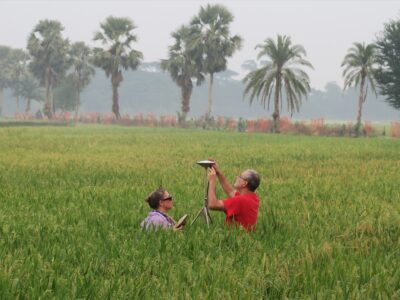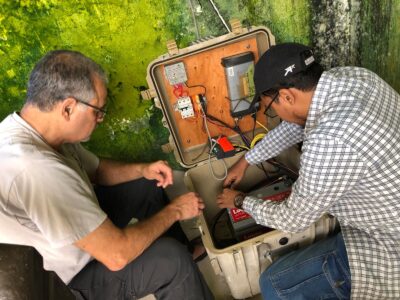Part 2 of a series on tracking landscape changes in Bangladesh. Read part 1 here.
The next day, February 26, we headed west from Khulna to Baintola in Assasuni District to service my GNSS measuring land subsidence, make elevation and sedimentation measurements at the RSET-MH (rod surface elevation table-marker horizon) and take core samples using an auger. Together, these will contribute toward understanding the balance of sea level rise, land subsidence and sedimentation, critical for the low-lying delta in Bangladesh. This is the fourth of nine sites in coastal Bangladesh that we are visiting during this part of my trip.

It was again a long drive so we started at 6 am stopping for breakfast and tea. In this area, we passed many shrimp farms where the soil is too salty for rice. Many fields were fallow and used for grazing cattle in the dry season. Rice can only be grown during the monsoon season. However, we would occasionally see rice paddies that used a special salt-tolerant variety. After hours of driving, we stopped about 5 km north of the site. From here on the road is so bad that we couldn’t take the van. We switched to two electric bicycle vans. And the road was as bad as advertised. The monsoon had taken its toll and the bricks of the road were misplaced, washed away or upturned. It took most of an hour for that last stretch. We did finally reach the school/cyclone shelter with the GNSS on its roof. Joined by Sakib from BRAC, the world’s largest NGO. BRAC is part of a project I am involved with designing interventions for adapting to climate change is SW Bangladesh.

We lugged the batteries and equipment up the ladder to the roof. As it turned out, the batteries were still good. However, the modem was not connecting. I downloaded the data, and with help over the phone from EarthScope, I logged into the modem and upgraded its settings, however, we still could not connect. We hoped it was just the poor cellular signal, but this one did not connect later. I hope I can return in the future with an EarthScope engineer. Meanwhile the RSET team can download the data every 6 months, if needed.

From here, we took the van over an even worse road to join the RSET and auger teams, measuring shallow subsidence and sedimentation at their second site. This one is outside the embankment, but at the moment disconnected from the Kobadak River because it is being dredged. In 2019, we sailed up this river to establish this site. Now south of us it is completely cut off by shrimp farms. To the north, the dredging has been completed and new embankments are being built along the now smaller channel. Luckily, when we were done, the bicycle van driver knew an alternative route across the river that was good, and we sped along it back to our van.

Sakib took us to the BRAC office and another 5 pm lunch, then tea and snacks with members of the BRAC team that I had met in Dhaka. By the time we finished and drove back to Khulna it was well after 10 pm.

Luckily, the following day was very easy. Zohur and I had a GNSS site at Khulna University, 15 minutes away. It was in good shape and needed no work. We toured the university and went to lunch. Then Masud and I went to a meeting with the head of the regional Forestry Department, who is very interested in our work and its implications for sustainability of the Sundarbans Mangrove Forest.

Now it was time for us to go to the Sundarbans, the world’s largest mangrove forest. In the evening, we went to the ghat(dock), where we were met by the crew of the M/V Bawali. They loaded all our luggage and equipment onto the wooden country boat and sailed across the river to the Bawali. There are a number of familiar faces for Masud and myself, but for the other members of our team, it is their first time on the Bawali and to the Sundarbans. Masud’s wife, Afroza Mim, also joined us as she have never been to the Sundarbans.

As we ate dinner, the crew started sailing down the Pusur River before stopping for the night. By the time we woke up, the Bawali had resumed its journey towards Katka and we watched as the world’s largest mangrove forest passed by. We arrived in the early afternoon and went to the RSETs, accompanied by an armed guard against tigers. I do not have a GNSS here, so I tagged along, mainly helping the auger team. In the soft muds of the forest, we reached 4.4 meters, or almost 14 ½ feet.

After finishing our work for the day, we had time for some sightseeing. We took the country boat to the observation tower on the east side of the river. Since it was late in the day, we saw lots of the spotted axis deer. In fact, there was a herd of ~200 south of the tower. And plenty of monkeys as well. We watched them and took pictures. When we were satisfied, we went across the river to the Katka forest walk. Again lots of monkeys, and several small groups of deer. As the sun set, we crossed to the beach for the walk back. We passed the ruins of a 300 year old salt kiln. These have been used to measure subsidence as they are now no longer at or above the Spring High Tide level. We also passed the ruins of the forest service buildings destroyed by Cyclone Sidr in 2007. Waiting for us by the wooden walkway to our boat were two wild boar, calmly grazing at the beach. It was an amazing first day in the Sundarbans.

During the night the Bawali sailed west to Tincona (Triangle) Island. We missed getting to see the Sundarbans pass by, but this put us well ahead of schedule. In the morning the calm weather let us cross the 10-km wide Pusur River to Hiron Point. Like many tidal channels, the Pusur widens towards its mouth on the Bay of Bengal. Hiron Point is along a smaller tidal channel, but recently it has been accreting new land. We have to follow the marked channel to approach it. As we do, I realized that we forgot the GNSS toolkit on the Bawali. After dropping off the RSET/auger teams, we had to head back to the Bawali. To save time, the speedboat came out to meet us, so the delay wasn’t too long.

Luckily, we only need to change the batteries at HRNP. It has remained online, so all its data is collected daily via the internet. The monitoring also showed that the battery is shot. That went quickly, so we were able to join the others across the channel. Zohur joins the RSET team and I joined the auger team, which now includes Mim. After we finished, we had a snack of bananas and guava, then a long walk on the elevated walkway through the forest. The broken and crumbling wooden walkway I visited before has now been replaced by concrete. Near the end, there was an observation tower, but as it was midday, no animals were to be seen. Nasser and the country boat sailed around to pick us up at the far end of the walkway. We then had a cruise through s long winding tidal channel before meeting up with the Bawali.


Our stations in the Sundarbans are done. We stopped for the night in the Sundarbans, but tomorrow we will sail out of it. Our next stations are at villages that border the Sundarbans, and some of the RSETs are in the Sundarbans. The Sundarbans are a magical place and will we I miss it. We will also miss the complete lack of mosquitos thanks to saline to brackish waters of the mangrove forest.






Assasuni is not a district but a sub-district (Upazila) under Satkhira district in Bangladesh